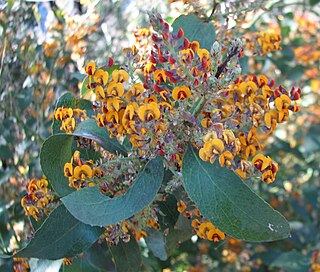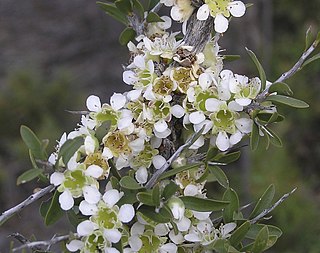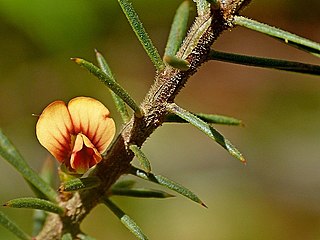
Thryptomene is a genus of flowering plants in the family Myrtaceae and is endemic to Australia. Plants in the genus Thryptomene are shrubs with small leaves arranged in opposite pairs and white or pink flowers. About forty-seven species of Thryptomene, occurring in all Australian states and the Northern Territory, have been formally described.

Chorilaena quercifolia, commonly known as karri oak or chorilaena, is a species of bushy shrub that is endemic to the karri forests of south-west Western Australia. It is the sole species in the genus Chorilaena. It has papery, broadly egg-shaped leaves with lobed edges and variously-coloured flowers arranged in umbels of five, the sepals and petals hairy on the outside and the stamens protruding beyond the petals.

Daviesia, commonly known as bitter-peas, is a genus of about 130 species of flowering plants in the family Fabaceae, and is endemic to Australia. Plants in the genus Daviesia are shrubs or small trees with leaves modified as phyllodes or reduced to scales. The flowers are arranged singly or in groups, usually in leaf axils, the sepals joined at the base with five teeth, the petals usually yellowish with reddish markings and the fruit a pod.

Verticordia huegelii, commonly known as variegated featherflower, is a flowering plant in the myrtle family, Myrtaceae and is endemic to the south-west of Western Australia. It is a sometimes an erect shrub, sometimes sprawling to almost prostrate. It has linear leaves and very feathery flowers in spring. The flowers are usually cream-coloured or white, becoming pinkish and reddish or maroon as the flowers age, giving a variegated appearance to the display.

Gompholobium huegelii, commonly known as common wedge-pea is a species of flowering plant in the family Fabaceae and is endemic to south-eastern Australia. It is an erect or spreading shrub with trifoliate leaves and cream-coloured to yellow and greenish, pea-like flowers.

Cordyline stricta, known as the Slender Palm Lily, or Narrow-leaved Palm Lily is an evergreen Australian plant. A shrub to 5 metres tall found in wet sclerophyll forest and rainforest, usually on the coastal lowlands. From near Bilpin, New South Wales further north to Queensland. C. stricta has become naturalised in Victoria.

Daviesia latifolia, commonly known as hop bitter-pea, is a shrub in the family Fabaceae. The genus Daviesia is endemic to Australia and the near off shore Islands. Daviesia latifolia is widespread in the Eastern states of Australia. The species was first formally described by botanist Robert Brown, his description published in Hortus Kewensis in 1811.

Daviesia corymbosa, also known as narrow leaf bitter pea, is a species of flowering plant in the family Fabaceae native to the state of New South Wales in eastern Australia. A shrub to 2 m (6.6 ft) high, it grows in sandstone soils in open eucalyptus woodland or heath. It produces showy flowerheads of red and yellow flowers in the spring and early summer.
Bossiaea nummularia is a species of flowering plant in the family Fabaceae and is endemic to New South Wales. It is a prostrate to low-lying sub-shrub with moderately hairy foliage, mostly broadly elliptic leaves, and yellow and red flowers.

Dasymalla terminalis, commonly known as native foxglove, is a flowering plant in the mint family Lamiaceae and is endemic to the south-west of Western Australia. It is a shrub with its branches, leaves and some of its flower parts densely covered with white, woolly hairs. The leaves are thick and soft and the flowers are tube-shaped, pale to deep pinkish-purple or claret red.

Leptospermum spinescens, commonly known as the spiny tea tree, is a species of spiny shrub that is endemic to Western Australia. It has thick, egg-shaped to elliptical leaves on a short petiole, white or greenish cream flowers, and fruit that remain in the plant for years after reaching maturity.

Thryptomene australis, commonly known as hook-leaf thryptomene, is a species of flowering plant in the family Myrtaceae and is endemic to the south-west of Western Australia. It is an erect, bushy and spreading shrub with upward-pointing leaves with the tip curving outwards, and flowers with white petals arranged spike-like near the ends of the branchlets.

Acacia saxicola, commonly known as Mount Maroon wattle, is a shrub belonging to the genus Acacia and the subgenus Phyllodineae native to eastern Australia.
Bossiaea cucullata is a species of flowering plant in the family Fabaceae and is endemic to Western Australia. It is a dense, many-branched shrub with narrow-winged cladodes, leaves reduced to dark brown scales, and yellow and deep red or pale greenish-yellow flowers.
Bossiaea praetermissa is a species of flowering plant in the family Fabaceae and is endemic to near-coastal areas in the far south-west of Western Australia. It is a shrub with many flattened, winged cladodes and deep yellow and reddish or maroon flowers.

Daviesia abnormis is a species of flowering plant in the family Fabaceae and is endemic to the south-west of Western Australia. It is an erect, hairy shrub with sharply-pointed, narrow elliptic to narrow egg-shaped phyllodes with the narrower end towards the base, and yellow flowers with faint red markings.

Daviesia nova-anglica is a species of flowering plant in the family Fabaceae and is endemic to northern New South Wales. It is an erect shrub with arching branches, sharply-pointed, egg-shaped to narrow egg-shaped phyllodes, and yellow flowers with red markings.

Daviesia acicularis, commonly known as sharp bitter-pea, is a species of flowering plant in the family Fabaceae and is endemic to eastern Australia. It is a small, wiry shrub with tapering, linear phyllodes, and single yellow to orange and dark red flowers.

Daviesia wyattiana, commonly known as long-leaf bitter-pea, is a species of flowering plant in the family Fabaceae and is endemic to eastern Australia. It is a sparse, erect shrub with long, linear phyllodes, and groups of four to seven yellow flowers with red or purplish markings.

Daviesia umbellulata is a species of flowering plant in the family Fabaceae and is endemic to eastern Australia. It is a slender shrub with egg-shaped or linear phyllodes, and groups of up to six yellow to orange flowers with maroon markings.

















